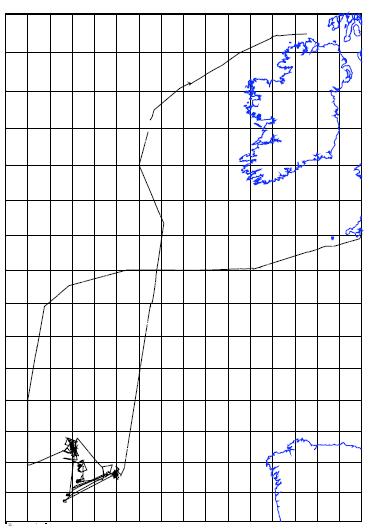 ©2020 Biological and Chemical Oceanography Data Management Office.
©2020 Biological and Chemical Oceanography Data Management Office.Funded by the U.S. National Science Foundation
The problem of quantifying the rate of gas flux across the air-water interface is one of the central questions of oceanography and is critical in the context of greenhouse gases and ocean-atmosphere budgets. The large uncertainty surrounding the flux of carbon dioxide (CO2) between the atmosphere and ocean prevent us from determining the partitioning of the sink of anthropogenic CO2 between the ocean and the terrestrial biosphere. This uncertainty also limits the ability to realistically model future atmospheric CO2 levels. The International SOLAS (Surface Ocean - Lower Atmosphere Study) science plan and implementation strategy highlights the need for an improved understanding of gas exchange. One of the stated goal of the SOLAS program to develop quantitative understanding of processes responsible for air-sea exchange of mass, momentum and energy to permit accurate calculation of regional and global gas and aerosol fluxes. This requires establishing the dependence of these interfacial transfer mechanisms on physical, biological and chemical factors within the atmospheric and oceanic boundary layers.
The investigator in this project will participate in the recently funded UK-SOLAS "Deep Ocean Gas Exchange Experiment", DOGEE. As part of this field experiment, two deliberate dual tracer patches will be released in close proximity to each other in the North Atlantic. One will be "labeled" with a surfactant in order to mimic the role of surface organic slicks in modifying gas transfer. The funded UK ship-based efforts will be enhanced with high resolution Lagrangian measurements of the air-sea interface. Specifically two Air-Sea Interaction Spar (ASIS) buoys, one in each patch, will be deployed to measure direct fluxes along with controlling surface physical processes (wind speed, wind stress, stability, surface waves, upper ocean turbulence and mixing, and key parameters governing mixed layer CO2 dynamics). In addition, a newly developed Air-Sea Interaction Profiler will be deployed to provide thermal and shear measurements in the very near surface. With these measurements, gas transfer process related specifically to surfactant effects, and to high wind processes will be better understood.
Broader impacts: The current lack of an adequate parameterization of air-sea gas transfer rates contributes directly to our inability to predict with certainty future concentrations of CO2 and other climate relevant compounds in the atmosphere. This project will improve the accuracy of the global ocean carbon dioxide flux estimates and increase our understanding of the causes of its variability. Another broader impact is that this proposal establishes an international collaboration between research institutes in the US (RSMAS/U. Montana/ODU) and the UK. The proposed measurements employ state-of-the-art instrumentation, which will enhance the DOGEE experiment. The opportunity to participate in this experiment, and access to the data for subsequent analysis will provide for a unique dataset with which to increase our understanding of the role of air-sea CO2 exchange in influencing climate. The project will involve students as undergraduate and post-graduate research assistants. The University of Miami is a Hispanic Serving Institution and thereby fosters the participation of under-represented groups in science and engineering. The data will be made available through several data bases via WWW. The project will contribute to the active outreach activities coordinated through the RSMAS Dean's Office.
This project is a contribution to the international SOLAS program.
PUBLICATIONS PRODUCED AS A RESULT OF THIS RESEARCH
Note: When clicking on a Digital Object Identifier (DOI) number, you will be taken to an external site maintained by the publisher. Some full text articles may not yet be available without a charge during the embargo (administrative interval).
Some links on this page may take you to non-federal websites. Their policies may differ from this site.
Brooks, I.M. et al. (M.D. DeGrandpre 12th of 54 authors in alphabetical order). "Physical exchanges at the air-sea interface: UK-SOLAS field measurements," Bulletin of the American Meteoroligical Society, v.90, 2009, p. 629. doi:10.1175/2008BAMS2578.1
Byrne, R.H., DeGrandpre, M.D., Short, R.T., Martz, T.R., Merlivat, L., McNeil, C., Sayles, F.L., Bell, R. and P. Fietzek. "Sensors and systems for observation of marine CO2 system variables," roceedings of OceanObsâ??09: Sustained Ocean Observations and Information for Society (Vol. 2), v.2, 2010. doi:doi:10.5270/OceanObs09.cwp.13
Turk, D. Malacic, V., DeGrandpre, M.D. and W. R. McGillis. "Carbon dioxide variability and air-sea fluxes in the northern Adriatic Sea," Journal of Geophysical Research, v.115, 2010. doi:doi:10.1029/2009JC006034
Edson, JB; Degrandpre, MD; Frew, N; McGillis, WR. "Investigations of Air-Sea Gas Exchange in the CoOP Coastal Air-Sea Chemical Exchange Project," OCEANOGRAPHY, v.21, 2008, p. 34. View record at Web of Science
| Dataset | Latest Version Date | Current State |
|---|---|---|
| SAMI-CO2, SAMI-pH, temperature and dissolved oxygen from multiple moorings near Media Luna Reef, Puerto Rico from 2007-2008 (DOGEE-II project, NH10_ShelfBreak_MLR project) | 2016-01-12 | Final no updates expected |
| SAMI-CO2 pCO2 temperature and oxygen time series dataset from multiple buoys in the NE Atlantic Ocean, west of Iberian Peninsula and Ireland from June to July 2007 (DOGEE-II project) | 2016-01-06 | Final no updates expected |

Principal Investigator: Michael DeGrandpre
University of Montana
UK Surface Ocean - Lower Atmosphere Study [UK SOLAS]